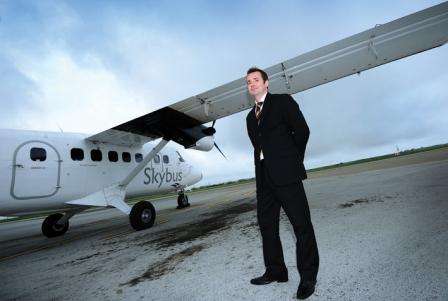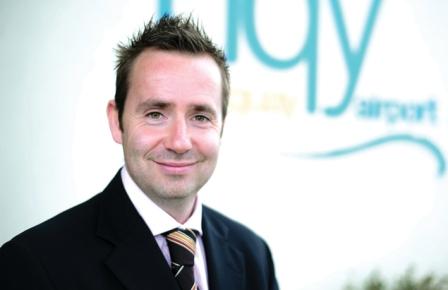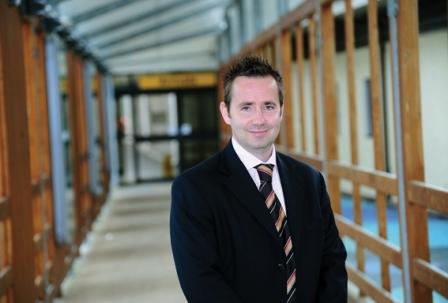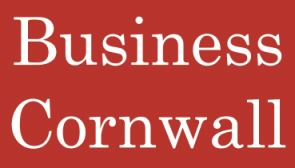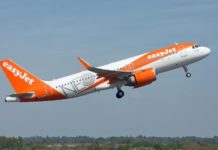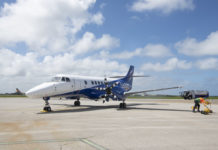You could say that Al Titterington has the smell of aviation fuel in his nostrils. Ever since being a baggage handler at Leeds Bradford airport, Titterington has been captivated and driven by the whole airport environment.
It has been a challenging career choice, however, whether it has been converting Doncaster Airport into a civil operation, or overcoming planning obstacles at Coventry.
There have never been any shortage of challenges at Newquay Airport, either – RAF, Council ownership, recession, development fees, Enterprise Zones, airlines closing. Life running a regional airport is never dull.
 Business Cornwall: What is it that first attracted you to airport management?
Business Cornwall: What is it that first attracted you to airport management?
Al Titterington: I did an economics degree first of all, and set up an aviation consultancy business with my father. But three months after graduating from Newcastle University, September 11 happened and the market just plummeted and the consultancy work just dried up.
So I went to work at Leeds Bradford as a dispatcher and baggage handler and it was the whole airport environment and smell of aviation fuel that got me. One day I was doing some work with the ops manager, and he told me how 25 years ago he had started as a baggage handler and was now operations manager.
I really wanted to get into that role but didn’t want it to take 25 years, which led me to doing my Masters degree in airport management.
BC: Where was your first job after your Masters?
AT: Robin Hood Doncaster Airport. It has some similar characteristics to Newquay Airport, in that it was a former RAF base converted into a civil operation. I worked on the legislative side of getting the airport up and running, and financial planning. It was a very hectic eight months to a year.
On the back of that role, TUI had just bought Coventry Airport, because they were setting up Thomsonfly.com there. But let’s say the previous owners of the airport hadn’t exactly played in line with planning frameworks.
The local authority had taken enforcement action to close the airport because they had basically built the runway extension and the terminal without planning permission. So there was a cry for help to sort out what they inherited. They ran an airline but not an airport. So they wanted myself and a colleague to go in and run the airport and get it back on an even keel and back in favour with both the planning authority and CAA because there had been a number of non compliances.
BC: And then onto Newquay?
AT: Yes, I came here in 2006 as operations director. At that time SERCO had the management contract for the terminal and Cornwall County Council, as it was then, were unhappy with the performance so decided to take it in house. So again I helped with the transition from an RAF base into a civil airport, again writing the licensing documentation etc. And then in January 2010, I was named MD.
BC: What’s involved with running an airport?
AT: Anything and everything! My remit covers not just the passenger operation but also the finance management, admin and the commercialisation of the airport.
Up until Jan 2010 my role was purely operations, then I took on other aspects of finances, commercial development, admin etc, all that sits under my remit.
BC: The commercial aspects must be very different from the passenger side.
AT: When I first took over the MD’s job it was very apparent the airport wasn’t going to get in a financially sustainable position based purely on passenger numbers alone.
Given its size and location, the number of people who live and work in Cornwall and those who visit wouldn’t get you up to that magic number in the industry, probably about 950,000 passengers, which you’d probably break even on, and there’s 550,000 people in Cornwall, not all of whom leave the county. Then within a 60 minute catchment of us you have Exeter Airport.
BC: Does the focus always have to be on visitors coming into Cornwall, rather than residents going out?
AT: It’s both, but it is a very different market. Those going out are mainly going for business, to business districts like Manchester and London. But in summer there’s a demand on leisure traffic, which has a different profile and a different type of operator.
The route development strategy has to focus on where there’s demand at both ends of the route, at the times airlines want to serve it.
BC: How does it work getting new routes?
AT: We go to the airlines. We have a catchment model which tells us where everysingle person in Cornwall is flying to and the people who are flying into Cornwall.
This core data allows us to approach an airline to say this is our catchment model, this is what we feel will work for you in terms of a service, this is the commercial deal we are willing to offer you, and this is the marketing plan that would sit alongside that.
Then it’s for their consideration and if the size of their aircraft would fit that demand. That’s something we have to consider as well. If the average demand for flying to Glasgow is 30 people on that service, there’s no point me going to somebody who only operates a 78 seat airplane, it’s not going to work. I’ve got to target someone who has that type of aircraft to service that demand. Airplanes that fly empty are losing money, that’s obvious economics.
They’ll haggle commercially; you may do some incentive deals to get the traffic in. Like anything, you incentivise early on and then get your full reward in the second, third, fourth and fifth years.
BC: So they pay you for landing rights?
AT: There’s loads of different models, different airlines like it in different ways. Some will pay for landing and the number of passengers; others will just want one charge. We have variants, but of course minimum costs, too. And at an absolute minimum I have to be covering my costs of operating that flight.
You can operate loss leaders if you are operating a number of sustainable routes that are making profits just to bring in additional business. But where we are now, we have to make sure we’re getting value for money for the Council, and that every single route we have covers our costs and makes a profit.
BC: Is it an advantage having such a long runway?
AT: It’s an advantage in that all airlines like long runways – they don’t have to throw the anchor out the back, they can just slow the airplane down. If you throw the anchor out the back, you’re on the brakes, it costs a lot in fuel and aircraft maintenance. If you have a long runway you’re in to a smooth slowdown.
RyanAir was a prime example. Although they don’t operate here anymore, their demand on every airport is that they have a minimum of 2000 metres of landing distance, again for that reason so they’re not having to throw the anchor out the back because it costs money on the airframe.
BC: But they pulled out over the airport development fee you charge passengers?
AT: Yes, in the summer 2010. They’ve pulled out of all airports that charge an airport development fee. We still speak to them, but they are very much “remove the ADF and we’ll come back”.
BC: And Air Southwest is no more. How much of a blow was that?
AT: From the revenue side, absolutely, you can’t disguise it when you lose that number of services. But what it does present is an opportunity. The cloud had been hanging over the airport and Air Southwest for about 18 months since Sutton Harbour announced they were going to sell it in May 2010.
But because they were the dominant carrier, no one else would come in on those routes while there was already an incumbent, because there wasn’t a demand. They would end up killing each other and losing lots of money.
With Air Southwest out now and not all the eggs in one basket so to speak, we can create opportunities with new carriers. We’ve seen Flybe pick up the Manchester service, Logan Air picking up Glasgow, and we’re in fairly advanced discussions with two other airlines picking up three other routes, which will give us a basket of airlines rather than one dominant carrier.
Like anything, if your major carrier goes to pieces, it’s obviously going to have a significant impact. And the timing of the announcement was unfortunate, because it was towards the end of the summer when airlines have already got winter schedules programmed and a lot of airlines are thinking 15 months in advance. And remember it’s a difficult market, we’re in the middle of a recession.
When we became a civil airport at the end of 2008, it was just as the economy was plummeting into recession. It wasn’t a good time, but you can’t cry over that, you’ve got to make the best. But the encouraging thing for us is that airlines are showing the interest. The challenge for us is to increase passenger numbers.
AT: The forecast for this year is about 195,000 which is down from about 400,000 in 2008/09.
BC: Is that directly because of the economy?
AT: Effectively there are four reasons. RyanAir is a high volume carrier and pulled out because of the airport development fee; Air Southwest as the dominant carrier operating eight routes when it ceased; let’s not forget volcanic ash, which killed a lot of airlines and airports back in 2009; and the general economic climate isn’t good. It all has an effect. But the signs are from the passenger market, that things are starting to look up.
BC: Is there a future for domestic flying?
AT: Absolutely, and that’s the encouraging thing, that airlines are showing the interest. It might not be the year-round service, or the daily or double daily service, which happened in the boom times, but there is definitely a demand, particularly for business connections. Our London Gatwick market is extremely strong, and accounts for probably just short of 45% of our overall passenger numbers.
BC: For a short while Air Southwest flew into London City. Did that just not work?
AT: It worked for us. The load factors coming out of Newquay were quite strong and they were pleased with that, but the people in Plymouth weren’t utilising the service, which obviously affects the cost of operating the flight and London City is an extremely expensive airport.
BC: Same problem with flying to Heathrow?
AT: Heathrow is the most expensive airport in the UK and probably in Europe. And it’s only going to get more expensive with no third runway happening. They’re chasing larger aircraft because they carry more passengers. To buy slots at Heathrow, the minimum you are going to pay is seven figures.
And you’ve got to get payback, and in terms of the number of people flying out of Newquay, it’s just not going to happen.
BC: What is the scope for more international flights out of Newquay?
AT: Summer destinations is a big one which we’re focusing on. The demand is there, but with our location, airlines don’t like flying empty airplanes down to Newquay because of the cost. A 737-800 flying down from Birmingham to Newquay would cost about £2k. So they’ve straight away got that cost to make back on the yield.
We’re looking at and talking to operators now that could potentially do what we class a ‘W’ pattern which may be Birmingham to Malaga, Malaga to Newquay, Newquay to Malaga, and Malaga back to Birmingham.
BC: Would it never be feasible for airlines to base those planes here?
AT: Not that size of aircraft to get down to southern Spain. There just aren’t enough people to fill it on a daily basis. And ifaircraft aren’t flying, they’re not making money. But for a Q400 which Flybe operates to Gatwick, yes there is, because they have that demand and can fly that aircraft all day long out of Newquay.
But for a tour operator, we’re really looking at a series of charters, which have been really successful, going out at 97%-98% full which is really good. There is a demand and we’re in talks with three of four tour operators for next summer, but more likely for 2013.
We know there’s that demand there. There are 32,000 with a Cornish post code that fly to Malaga every year out of Exeter and Bristol.
BC: Is that a big part of the job, knowing people’s holiday habits?
AT: It has to be. You need the data. In the boom years previously, if someone had a spare aircraft they might chance it and fly to Newquay, but these days airlines are far more careful. But like every market, it will recover and airlines realise there is a demand for air services to and from Cornwall and that’s the reassuring bit.
BC: On the other side of the coin is the commercial development of the airport site. How important is the new Enterprise Zone?
AT: Very. I wouldn’t say it’s the be all and end all, but it’s a nice cherry on top. It gives a lot of focus and attention in terms of marketability of the airport for the aerospace activity we’re looking to develop here, and also the business park land.
Chris Pomfret said he’d rather be chairman of an LEP that has an Enterprise Zone rather than one that doesn’t, because it brings benefits particularly on business rates and potentially on capital allowances. And it really raises the profile of being able to market your asset.
The feature of our bid was the amount of land we have here, the clear air space, long runaway, development opportunities, access into the Convergence programme. When you bring them all together and put the Enterprise Zone on top, it is quite a significant proposal.
What we inherited from the MoD is a significant land asset. Previously they couldn’t develop any commercial offerings, so basically we’ve inherited a big property portfolio with not a lot on it. Other regional airports already have significant property portfolios around their land which generates revenue to supplement what happens on the passenger terminal side. This is what we need to get to and hopefully the Enterprise Zone will give us a significant boost.
BC: Without the Enterprise Zone, would the passenger operation still be secure?
AT: I think it would. The Council is 150% committed to having an airport in Cornwall because of the economic benefits it brings which is significant in terms of GVA and employment opportunities.
BC: Is there a growing aviation skills base here?
AT: Cornwall has a strong aviation heritage both on the civil and military sides. RAF St Mawgan, Culdrose, while it’s over the border, Devonport, and on the civil side Lockheed Martin which is prevalent.
So there’s a lot of good skills already here, it’s how we develop it as we go forward. A skills base is very important in underpinning future development of the airport.
BC: And going forward do you think we’ll see some big international names attracted to the airport.
AT: We’ve already got one with AgustaWestland. Their development is very strong coming out of Newquay and we’re always in ongoing discussions with them about how they’re going to create additional capacity at the airport. Over the next 12-18 months they will hopefully expand fairly significantly.
BC: How is the Council as an owner? In an ideal world I guess they would like to sell the airport?
AT: Yes, the chief executive Kevin Lavery has stated on a number of occasions the airport isn’t core business for them. When the Council thinks the time is right to go and look at the market then yes, that’s always been the strategy. The Aviation Act was set up to take airports out of local government control, because it’s a private sector business. It’s not highways, it’s not social care or schools, it’s a commercial entity.
BC: So one of your tasks is to turn it into an attractive commercial proposition?
AT: Yes and to make sure the structures are such that they can be readily transferred into the private sector, if at some point in the future the Council feels the time is right.
BC: I guess the economy would have to improve first?
AT: You would think so.
This article first appeared in the November 2011 issue of Business Cornwall magazine
(photos by Toby Weller)


